There’s good news and bad news about the unauthorized cones on SW 3rd Avenue that have made that street’s bike lane much safer and comfortable to ride in. The bad news is most of them are gone as of this morning: Only four of the original 14 are still standing. The good news is that the bike lane stripes have magically become much more visible even without the cones.
Compare the photo above from this morning with the one below I snapped on Monday:
Yes, it appears that for the first time Portland’s official bureau of transportation has responded to the unofficial bureau of transformation*.
Anonymous activist group PDX Transformation unveiled their highest profile deployment of unauthorized traffic cones on Monday. They put up 14 large orange cones in the buffer zones of the bike lane on Southwest 3rd Avenue between Burnside and Stark. The action earned them yet another big headline from the local media and it got them support from all three leading mayoral candidates.
Advertisement
So far the Portland Bureau of Transportation has stayed relatively neutral about the group in the press. A PBOT spokesperson made it clear the actions were not legal, but the agency also said they shared the concerns highlighted by the actions and they didn’t plan to run out and confiscate the unauthorized signs and cones. But since PDX Transformation did their first action three months ago, PBOT had yet to respond with actions of their own. Until now.
Today we noticed the the bike lane striping on SW 3rd Avenue has a nice fresh coat of paint. The lanes are as bright as when they were first installed. It’s a nice gesture, but it’s very obvious to us that even fresh paint is not as good at encouraging safe and legal driving behavior as real, physical objects like plastic cones. I wasn’t out there for more than a minute this morning before someone encroached into the lane prior to a right turn — the exact type of behavior the cones have done a great job to discourage.
PBOT’s response here shouldn’t come as too big of a surprise. The agency has a long and laudable track record of responding to citizen concerns about traffic safety problems. The city — and especially Commissioner Steve Novick in City Hall — have also enthusiastically embraced this type of tactical urbanism in their ongoing partnership with Better Block PDX.
Nevertheless, to see this type of reaction from PBOT is encouraging. And it’s also likely to embolden PDX Transformation. After we shared news of the restriping this morning they tweeted, “Thanks, @PBOTinfo! Now let’s talk about permanent barriers.”
UPDATE, 10:28 am: PBOT says this striping was not done in response to PDX Transformation. “Yes there was some re-striping down downtown, but no, it wasn’t in response to the cones,” PBOT spokesman John Brady just shared via email. “With the dry weather, we can start to ramp up our striping activity and we stripe where there is a need, e.g., because of a recently completed paving project or because the lines have faded and need refreshing.” Brady said crews were out early this morning and also striped: the 8” bike lane line on the new pave out on NW 16 from Glisan to Davis; NW and SW 3rd Ave from NW Glisan to SW Market; SW and NW 2nd Ave from SW Market to NW Everett; N and NE Russell from just west of N Interstate to NE MLK Jr Blvd; and N Kerby from N Vancouver to N Russell.
— Jonathan Maus, (503) 706-8804 – jonathan@bikeportland.org
BikePortland can’t survive without subscribers. It’s just $10 per month and you can sign up in a few minutes.


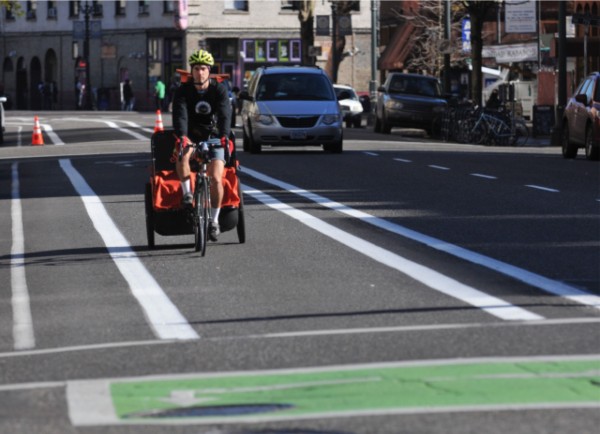
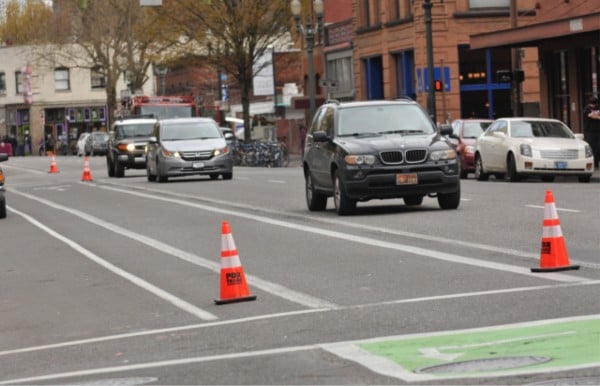
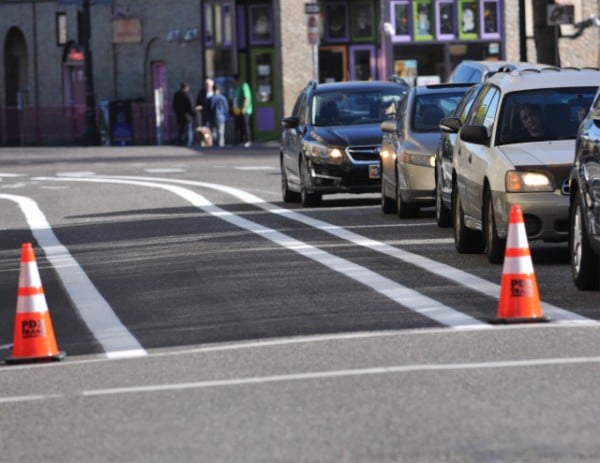
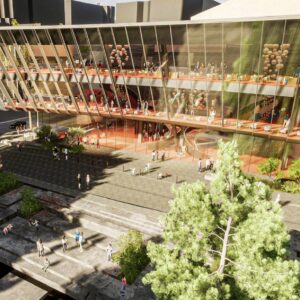

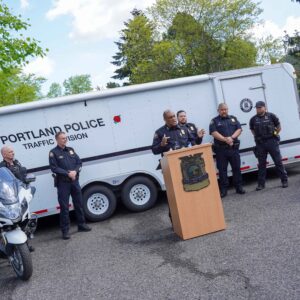
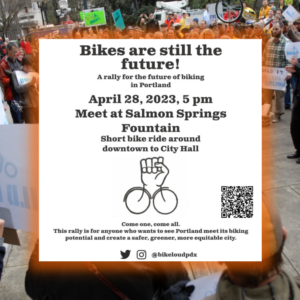
Thanks for reading.
BikePortland has served this community with independent community journalism since 2005. We rely on subscriptions from readers like you to survive. Your financial support is vital in keeping this valuable resource alive and well.
Please subscribe today to strengthen and expand our work.
This still doesn’t solve the problem with this bike lane: that’s it’s not curb side and protected by a barrier.
Once it is it should be signed for two way travel.
Two-way cycleways are less safe than one-ways because they create additional conflicts with turning motor traffic. Plus, they are more narrow. A better solution would be to have a couplet cycleway on 2nd Av. However, a temporary two-way would be acceptable until 2nd Av can be upgraded.
Amen, the Seattle 2nd Ave. two-way lane is a nasty little cattle chute. Seattle downtown traffic is slow moving and NOT scary to ride in–the two way clusterf*&^ was terrifying!
if you going up the hill, it’s probably the nicest connection downtown has. The problem is it dumps you in the middle of traffic when it ends, that’s getting fixed.
>A better solution would be to have a couplet cycleway on 2nd Av.
Then people will keep biking on the sidewalks on 3rd.
Salmon gonna salmon.
Exactly. So give them a place to do it that isn’t a congested sidewalk.
Nope. No wrong-way bike lane on the wrong side of the street. That’s what congested sidewalks are for. Add a bike lane on the other side of the street, maybe — but it can’t be a good through route due to signal progression, so probably not worth the effort. Riding the wrong way should be difficult (maybe illegal) and will probably seem rude. Too many people sidewalk biking half the block to a destination — get a bigger sidewalk? Too many through bikes racing down each block to stop at a red light? Too many straw men on the sidewalk?
Paint is not protection.
True, but space gives people that have made mistakes more time to correct than no space.
But it still guides bicyclists and (non-distracted) drivers where they should be on the road. Also, hashed buffers would be better than these non-hashed spaces, but they have to be painted manually and are difficult to convince agencies to actually pay for.
I guess @PBOTrans is effective. Keep it going!
just simple question, anyone see the total change in driving habits downtown? pure madness now.. red light blowers and distracted driving
Yesterday evening’s rush hour did seem unusually aggressive, in particular more sports cars and convertibles being pushy at pedestrians (okay, me) in the crosswalk. Their idea of celebrating the lovely weather is to drive fast, I guess?
I think part of the problem right now is that the Broadway Bridge is closed, making traffic much worse on the other bridges, and that traffic backs up well into downtown. From NW 23rd to Glisan/Cesar Chavez today, starting at 5:15 pm, took nearly 45 minutes in my (gasp) car.
California, Texas, and Arizona (as well as about 40 other states) have been moving here in mass the past 2 years. They bring it with them.
ohh and jay walkers
Please don’t use that auto industry coined slur. Mid/block ped crossing should be completely legal if you lookout and do not infringe on other traffic’s right of way. I realize you probably mean someone distracted stepping out in front of you, which they should not do, but any shade of victim blaming of peds is a sensitive issue.
Speaking of NW 16 from Glisan to Davis… it’s really disappointing that the street was repaved and then re-striped with the exact same narrow door zone bike. Given that most of the drivers on NW 16th are coming off or getting onto the freeway this is a section of road where a protected or buffered bike lane would be warranted.
Granted, it would only have been three blocks, but it could have been a start to an upgrade of the whole street. A real missed opportunity by PBOT, IMHO. I hope they don’t make the same mistakes when they repave much longer sections of NW 14th or SW Jefferson in the next couple of years.
The cones have shown that paint is not something to get excited about
Nice work PBOT and PDXtransformation
I think it’s a great bike lane. Cones are fine, too.
For those that think all bike lanes should be protected, well, I’d rather have 5 miles of new unprotected bike lanes than 1 mile of protected bike lane. or 1/2 mile. Or whatever the cost breakdown is.
Sure, there’s potential to increase the size of the funding pot, but I think that comes from thanking the city for what is currently being delivered, and increasing requests for improvement at the same time is what will get us to higher levels of funding.
FWIW,
Ted Buehler
I respectfully disagree with you, Ted.
I surely don’t think that every lane should be protected, but ones in areas with high car volume (including the city center) absolutely should be. And I also disagree that five miles of dangerous painted lanes are better than one safe one. We shouldn’t have to sacrifice safety for coverage.
Thanking PBOT for substandard bike infra is how we get more substandard bike infra. We need to be calling out the substandard infra for what it is, and asking for better.
When it comes to a choice between nothing and 5 miles of buffered bike lane I will always support mere paint on the road. Foster is a good example of this. I was a vocal supporter of a raised bed cycletrack here and in my testimony to the city. Nevertheless, when it became clear that this was not going to happen, I switched to advocating for buffered lanes instead of a conventional bike lane. Do I believe that buffered lanes are enough on Foster? No. Are they better than the conventional bike lanes that were proposed for the entire project? Definitely.
I think it’s also important to not forget that paint does work in some contexts. For example, I think Portland should make far more use of advisory bike lanes in locations where they currently have truly awful 3 foot bike lanes:
https://www.google.com/maps/@45.5377816,-122.6218635,3a,75y,128.65h,70.46t/data=!3m6!1e1!3m4!1s0zijlSpQuOmlx6WvR96bHw!2e0!7i13312!8i6656!6m1!1e1
The problem with Foster is that the bike lanes are just being used as an easy way to create a road diet without moving the curb (thus increasing the cost). I still stand behind my statement that Foster needs protected bike lanes, but the fact is that the Foster Streetscape Project was never intended to be a bike project. The bike lanes are just a side effect of the road diet and sidewalk improvements. Are door zone lanes better than nothing? Sure. But they’re still not enough to attract the 8-80 crowd and thus are still substandard.
I still support the project and think it will be a boon for Foster Road, but with the caveat that the bike infra is inadequate.
As far as advisory bike lanes, I do think they can work on some roads, although only if all parking was removed and the roadway narrowed significantly. Additionally, they are technically illegal to install in Oregon since it is illegal to drive in any bike lane.
True … but when it comes to making preserving parking near curbs, PBOT and the PPB is willing to systematically ignore state law.
I agree 100% that that law needs to be enforced, but the primary difference here is a lack of enforcement of a current law vs. installing something known to be illegal. Not that I agree with either excuse.
Amusing when I went by the Multnomah Village bike paths going west from I-5. 3/4th of the cars that were parked on the left where the bike lane was between the marked car parking were parked in the bike path and not on the marked parking. It made a wierd pattern for bikes to weave, zig-zaging between cars. Of course the 4 bikes I saw going through there were in the traffic lane. No problem slowing for them. The SUV’s and the pickups got kind of hot though by blasting their horns at me. OH WELL! :=)
Why should that lane be protected?
Is there evidence that cyclists are being hit in those bike lanes?
There is are real downsides to protected bike lanes, besides the expense. They make turns inconvenient – suppose a protected bike lane is on the right side of the road and you want to turn left, now you either need to make a very abrupt diagonal cut through the intersection (dangerous), or use the crosswalks like a pedestrian (slow). They make intersections dangerous – cyclists going straight vs cars turning, with poorer mutual visibility than with a buffered bike lane. They get very confusing at driveways, as cars try to get in and out through openings in the barrier and inevitably get balked there, blocking cyclists. They complicate street cleaning.
I do see the appeal of wands, curbs, bumpouts with channels for bikes, cones, etc at the start and end of each block, to discourage turning cars from using the bike lane, to clearly delineate the bike lane, to provide a shorter pedestrian crossing (that would be the bumpout).
A protected bike lane with a protected intersection addresses all the issues you describe. There would be a protection island in the intersection and to turn left, one would make a two-stage turn. See: http://protectedintersection.com/ . Slower yes, but isn’t a small delay worth the vast improvement in safety?
I also don’t buy the argument that we should only build protected infra where there is evidence that cyclists are being hit at that location. We need to be proactive, not reactive. We shouldn’t wait around for someone to get hurt to install safe cycling infra. Additionally, protected bike lanes increase usage and mode share, and thus increase safety due to the safety in numbers principle. The average person does not make decisions based on data – instead relying on emotion – and bike infra should not only be safe, it should feel safe.
How often would two stage actually turns be slower downtown? Unless your destination is on the block you turn on to won’t you get stuck waiting at the next red light? And won’t that light turn green around when you would have arrived at it if you made a two stage turn?
A number of years back I spent some time riding around Copenhagen, where there are protect lanes all over the place along with two-stage turns. I remember initially worrying that making the two-stage turns would mean it took ages to get around (this was back when I was young and flash, and every second counted, dammit!), but I quickly became a fan. As you say, it actually isn’t slower most of the time, as making a one-stage left through oncoming traffic often just gets you to the next red light quicker; and, to my surprise, the reduced stress from the much easier left turns was wonderful and enabling – no need to avoid routes with scary left turns any more as there weren’t any. Cycling felt like an unstressful way to get around the city rather than a daily thrill-ride.
It feels like the bike lane to nowhere, right? Nice full bike lane then abruptly ends.
Just a few more blocks and it would have provided a useful connection to the Hawthorne Bridge and to PSU. It’s time for this city to develop some backbone when it comes to cyclist level of service.
The best lane painters paint the stripe a couple inches farther out each time it wears off. Terwilliger would have 8ft lanes in a few months if they would keep it painted.
These “unauthorized” traffic cones seem to have remained in place for days despite threats from the city to remove them.
Were they glued in place or what?
PBOT should put planters in the space between the car lane and bike lane. We need more than a stripe to calm the traffic down and give permanency to the bike lane.
Ohhhhhhhhhhhh, a really thick line of paint. That will stop a car…right in it’s tracks.
With superglue in it!